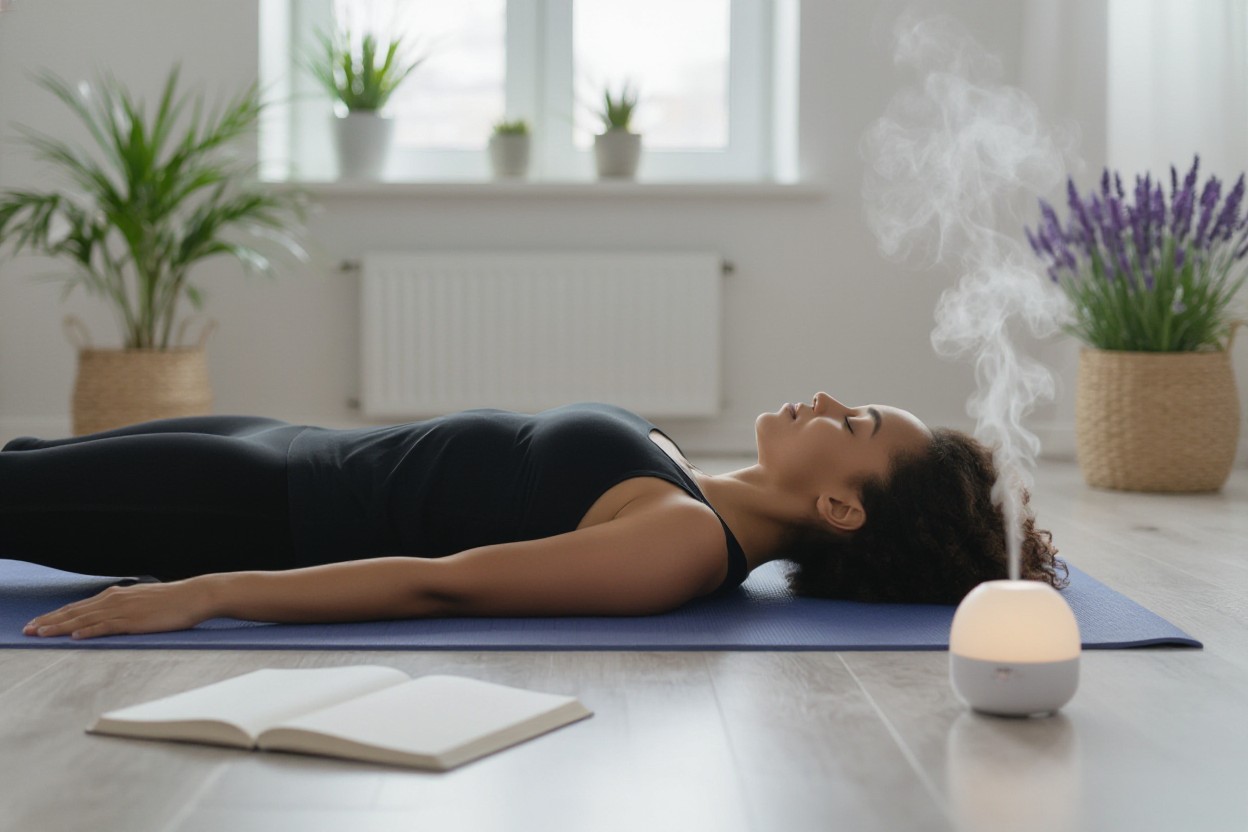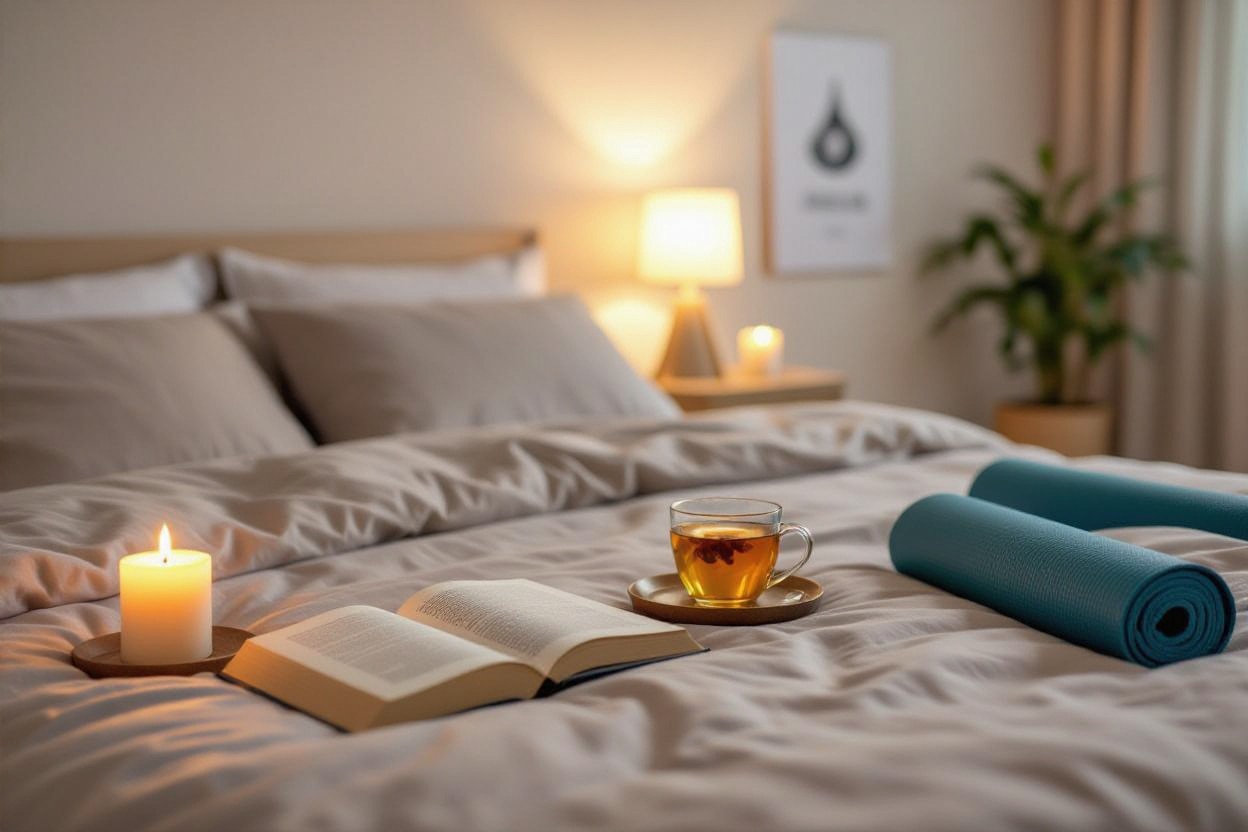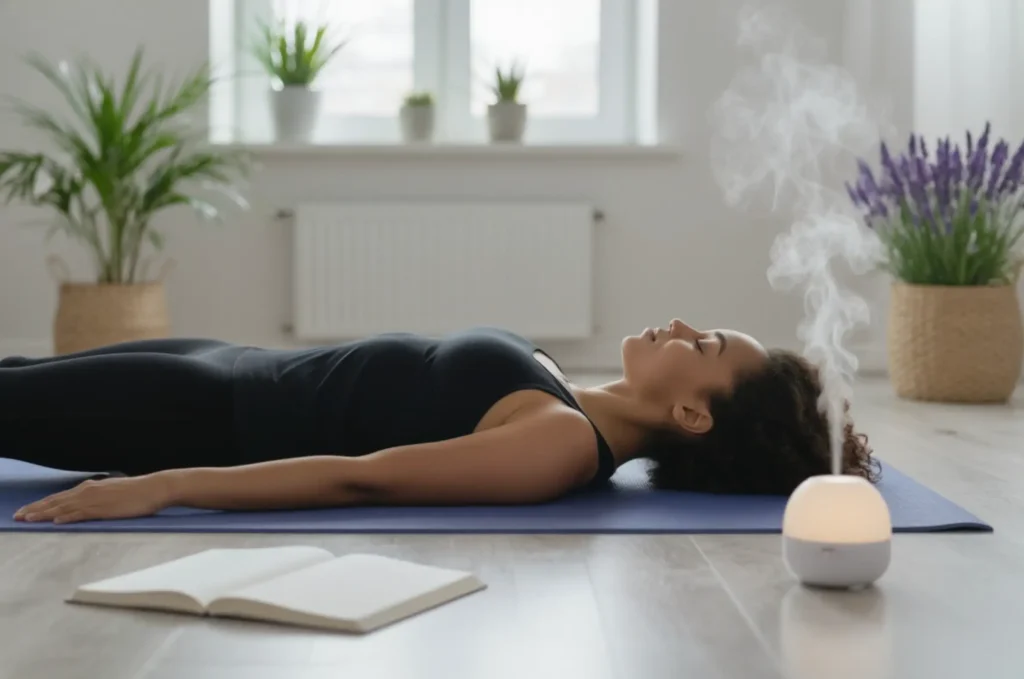Most of you can fall asleep faster and sleep more soundly by tuning your breath and bedtime habits; try gentle techniques like diaphragmatic breathing and guided nasal breathing, and learn more from this Breathing Techniques for Sleep guide to support your routine tonight.
why breathing matters for sleep
Your breathing pattern affects nervous system balance, heart rate, and calmness. When you slow and deepen your breath, your body shifts toward relaxation, making it easier to fall asleep and stay asleep. Small changes to how you breathe during the day and at night can improve sleep quality where you live, whether you’re in a city or a rural area.
simple breathing techniques to try
diaphragmatic breathing
Lie on your back or sit comfortably, place one hand on your chest and one on your belly. Breathe in through your nose for four counts, let your belly rise, then exhale for six counts. Do this for 5–10 minutes before bed to calm your nervous system.
4-7-8 breathing
Breathe in through your nose for 4 counts, hold for 7, and exhale through your mouth for 8. Use this when you feel wired at night; it helps slow your heart rate and signal relaxation.
alternate nostril breathing
Close one nostril with your finger, inhale through the open nostril, switch sides, and exhale. Repeat for 3–5 minutes to clear nasal passages and steady your focus before sleep.
bedroom environment and habit changes
Keep your bedroom cool, dark, and quiet. Use a humidifier or saline rinse if nasal congestion affects your breathing. Limit caffeine and screen time in the evening, and establish a consistent sleep schedule so your breathing and circadian rhythm align.
lifestyle tips that support better breathing
- Stay active with daily movement to strengthen respiratory muscles.
- Practice mindful breathing or short meditation sessions during the day.
- Maintain a healthy weight to reduce sleep-disordered breathing risks.
- Keep allergies managed with local solutions and consult a provider if symptoms persist.
when to seek professional help
If you snore loudly, wake gasping, or feel excessively sleepy during the day, you may have a sleep disorder such as sleep apnea. Talk with a local sleep specialist or primary care clinician to get an evaluation and tailored treatment.
tools and aids that can help
Simple devices like nasal strips or a supportive pillow can improve airway alignment; for equipment options see this product link. Use devices as part of a broader plan that includes breathing practice and sleep hygiene.
quick nightly routine (5–10 minutes)
1) Dim lights and silence screens. 2) Do diaphragmatic breathing for 5 minutes. 3) Try 4-7-8 if you still feel alert. 4) Set a comfortable sleep position and focus on steady nasal breaths as you drift off.
local considerations
Air quality and seasonal allergies in your area can affect breathing at night. Check local air advisories, use air purifiers if needed, and adapt routines to seasonal changes to protect your sleep quality.

Understanding the Importance of Good Breathing for Sleep
Your breathing pattern controls oxygen delivery, carbon dioxide balance and autonomic tone while you sleep; shifting from mouth to slow nasal breathing can increase heart rate variability and deepen slow-wave sleep. Practice paced breathing around 4–6 breaths per minute before bed to stimulate the parasympathetic response, which studies link to faster sleep onset and fewer nighttime awakenings, especially helpful if you live in busy urban areas with higher pollution levels.
How Breathing Affects Sleep Quality
Changes in airflow alter sleep architecture: shallow or obstructed breaths lead to micro-arousals, fragmented REM cycles and daytime sleepiness. Obstructive events measured by the apnea–hypopnea index (AHI) are classified as mild (5–15), moderate (15–30) and severe (>30), with higher AHI strongly associated with cardiovascular risk and poor cognition. You can monitor symptoms like excessive snoring, gasping, or nonrestorative sleep to assess whether breathing is eroding your sleep quality.
Common Breathing Issues During Sleep
Nasal congestion, habitual mouth breathing, snoring and obstructive sleep apnea (OSA) are the main disruptors; snoring affects up to 45% of adults and OSA prevalence ranges from about 9–38% depending on age and BMI. Upper airway resistance syndrome and positional breathing problems also fragment sleep even without full apneas. Identifying whether your issue is nasal, structural or positional guides the most effective natural and medical interventions.
Allergic or structural nasal blockage often responds to saline rinses, nasal dilators or targeted pillows that promote side sleeping; for positional snoring, raising the head or using a wedge pillow reduces collapse in many people. Persistent OSA with AHI >15 typically needs medical evaluation—continuous positive airway pressure (CPAP) remains the gold standard—while mild cases may improve with weight loss, positional therapy, or oral appliances. Consider a well-reviewed nasal aid for trial use: recommended product.
Natural Techniques to Enhance Breathing
Diaphragmatic Breathing
Diaphragmatic breathing shifts your breath from chest to belly, lowering rate from a typical 12–20 breaths per minute to about six during practice, which boosts heart rate variability and soothes the nervous system. Place one hand on your chest and one on your abdomen, inhale through the nose for four seconds so the belly rises, then exhale for six seconds; 5–10 minutes nightly can shorten sleep onset and reduce mild snoring.
The Role of Yoga and Meditation
Pranayama and short meditations train nasal breathing, reduce sympathetic arousal, and improve sleep architecture; examples include alternate nostril breathing (nadi shodhana), bhramari humming, and the 4-7-8 pattern. Practicing 10–20 minutes daily has been associated with lower anxiety and better subjective sleep quality in several trials, making these techniques especially useful if you live in high-stress urban environments.
Try a 15-minute pre-sleep sequence: 3 minutes nadi shodhana to balance airflow, 5 minutes of slow diaphragm breaths at six breaths per minute, 2 minutes of bhramari, then a 5–10 minute guided body-scan meditation; nightly consistency raises parasympathetic tone and often reduces time to fall asleep. For extra support you can use a simple breathing trainer like this recommended device, popular among travelers in cities like New York and London.
Creating a Sleep-Friendly Environment
Set bedroom temperature to 60–67°F (15–19°C) and humidity to 40–60% to reduce nasal congestion and discourage dust mites; run a HEPA air purifier overnight since HEPA filters remove 99.97% of particles ≥0.3 µm, swap bedding weekly, remove heavy rugs that trap allergens, and keep sleeping surfaces clear to improve airflow and reduce triggers that disrupt your breathing and sleep.
Optimizing Your Bedroom for Better Airflow
Open windows for 10–15 minutes before bed to flush stale air or use a window fan to create cross-ventilation; position ceiling or pedestal fans on low to circulate air without drying your nasal passages, keep supply vents unblocked, and choose an air purifier rated for your room size—manufacturers list coverage in square feet—to ensure 4–6 air changes per hour in typical bedrooms.
Using Essential Oils and Aromatherapy
Diffuse 3–5 drops of lavender, sweet marjoram, or chamomile in an ultrasonic diffuser 15–30 minutes before bed to lower anxiety and promote slower breathing, use eucalyptus or peppermint sparingly for short-term nasal relief, avoid diffusing directly near infants or small pets, and consult your clinician if you have asthma or pregnancy concerns.
Small clinical trials show lavender can improve subjective sleep quality and reduce anxiety; choose 100% pure imperative oils, store them in dark glass, and test a short 5–10 minute diffusion first to gauge your response—use a nebulizing diffuser for stronger scent without water. For product options see this recommended diffuser suitable for bedrooms.
Lifestyle Changes for Improved Breathing
Side-sleeping, keeping bedroom humidity around 40–50%, and using a HEPA filter if you live in high-pollen or high-pollution areas cut nasal irritation and snoring. Avoid alcohol within four hours of bedtime and finish heavy meals at least three hours before sleep to reduce airway relaxation. Simple aids like nasal strips or a supportive pillow that keeps your head elevated by 10–15 degrees can improve airflow and reduce awakenings.
The Importance of Regular Exercise
Aim for 150 minutes per week of moderate aerobic activity—brisk walking, cycling, or swimming—to strengthen respiratory muscles and improve nighttime oxygenation. Clinical studies show exercise can lower apnea–hypopnea index (AHI) by up to 25–30% independent of weight loss; adding twice-weekly resistance training helps build throat and core tone. Scheduling workouts earlier in the day and doing a 10-minute yoga or breathing routine before bed often improves sleep onset and reduces snoring frequency.
Maintaining a Healthy Weight
Losing even 5–10% of body weight often reduces snoring and sleep apnea severity because fat around the neck and abdomen narrows the airway. Tracking calories with a simple deficit—about 500 kcal/day—typically yields ~0.5–1 lb (0.2–0.45 kg) weight loss per week, and reducing neck circumference below risk thresholds (men ~17″+, women ~16″+) lowers airway collapse during sleep.
Use a combined approach: prioritize protein-rich breakfasts, Mediterranean-style meals rich in vegetables, legumes and olive oil, and limit late-night carbs to reduce visceral fat. Implement progressive resistance training 2–3 times weekly to raise resting metabolic rate; aim for a 300–400 kcal burn per session. If BMI remains >35 with persistent obstructive sleep apnea, discuss medical options—pharmacotherapy, structured weight-loss programs, or bariatric referral—with your clinician. Track progress with weekly weigh-ins, neck circumference measurements, and consider a supportive pillow or sleep aid product product to help maintain airway alignment while you lose weight.
Foods and Herbs that Support Better Breathing
Oily fish (salmon, mackerel), nitrate-rich beets and leafy greens, and antioxidant-rich berries reduce airway inflammation and support nitric oxide pathways that improve airflow; garlic and onions offer antimicrobial allicin, while spicy foods with capsaicin can temporarily clear congestion. Try a weekly serving of fatty fish (2–3 times) and add a daily cup of mixed berries or a beet salad to help lower inflammatory markers and boost nighttime breathing; for devices and supports you can buy on Amazon.
Nutrients to Include for Lung Health
Omega-3 fatty acids, vitamin D, vitamin C, magnesium and dietary nitrates each support different lung functions: omega-3s modulate inflammation, vitamin D (600–800 IU/day) supports immune response, vitamin C from citrus and peppers protects against oxidative stress, magnesium (about 310–420 mg/day) relaxes bronchial muscles, and nitrates from beetroot boost nitric oxide and airway dilation—combine varied whole foods to cover these needs and improve nighttime breathing metrics like oxygen saturation and snore intensity.
Herbal Remedies to Consider
Thyme and mullein act as expectorants and mild antiseptics, ginger and licorice relax airways and reduce cough reflex sensitivity, while eucalyptus oil (rich in 1,8‑cineole) has shown symptom improvements in several respiratory trials. Use dried thyme or mullein teas for gentle mucus clearance, ginger infusions for bronchodilation, and topical steam with eucalyptus for short-term decongestion to support clearer breathing at night.
Prepare herbs safely: steep 1–2 teaspoons of dried herb per cup for 8–12 minutes, drink up to 2 cups daily, and use 2–4 drops of eucalyptus or peppermint oil in a steam inhalation or diffuser—avoid ingesting concentrated necessary oils. Check interactions: ginger, garlic and ginkgo can increase bleeding risk with anticoagulants; eucalyptus should not be used internally in young children; consult your healthcare provider if you take prescription medications or have chronic lung disease.

Establishing a Relaxing Pre-Sleep Routine
Aim for a 30–60 minute pre-sleep routine that signals your body to shift into rest: dim lights to under 50 lux, set bedroom temperature to 60–67°F (15.5–19.5°C), and go to bed within the same 15–30 minute window each night to strengthen your circadian rhythm; consistent timing and low light exposure can shorten sleep latency and improve overnight breathing patterns by reducing nighttime arousal.
Wind-down activities for better breathing
Choose low‑arousal activities that ease the respiratory system: 10–20 minutes of gentle yoga or stretching, a 10‑minute warm shower to relax muscles, or 20 minutes of reading a print book; avoid screens 30–60 minutes before bed and consider using a humidifier or a sleep aid accessory in dry climates to keep nasal passages clear and reduce mouth breathing.
Breathing exercises to try before bed
Practice simple, timed techniques for 5–15 minutes: 4‑7‑8 breathing (inhale 4, hold 7, exhale 8) for 4 cycles to calm the nervous system, box breathing (4‑4‑4‑4) to steady rhythm, or coherent breathing at 5–6 breaths per minute (inhale 5s, exhale 5s) to boost vagal tone; small, regular sessions most nights often give better results than sporadic long sessions.
For more detail, start with diaphragmatic breathing—place one hand on your chest and one on your abdomen, inhale through the nose for 4–6 seconds so your belly rises, then exhale slowly for 6–8 seconds; follow with 4‑7‑8 for 3–6 rounds if sleep still feels distant. Track how long it takes you to fall asleep over two weeks—many people report fewer awakenings and shorter sleep onset after 7–14 nights of consistent practice.
how to improve breathing for better sleep naturally
why breathing matters for sleep
Your breathing pattern affects sleep depth, snoring, and daytime energy. By shifting to slower nasal breathing and reducing mouth breathing, you can ease anxiety, lower heart rate, and support deeper restorative sleep across different climates and altitudes.
simple breathing exercises to try
Practice diaphragmatic breathing: lie on your back, place one hand on your chest and one on your belly, inhale slowly through your nose so your belly rises, then exhale gently. Try 4-6 slow breaths per minute for 5–10 minutes before bed. Add box breathing or alternate nostril breathing to calm your nervous system and prepare your body for sleep.
bedroom setup and environment
Keep air clean and slightly humid to reduce nasal irritation. Use an air purifier and adjust humidity based on your local climate—dryer air in the United States Midwest or humid coastal air in the UK may need different approaches. Elevate your head slightly to ease airflow and choose breathable bedding materials for temperature regulation.
daytime habits that support nighttime breathing
Stay active, maintain a healthy weight, and avoid heavy meals and alcohol close to bedtime. Practice good nasal hygiene with saline rinses if you have congestion. If allergies affect you seasonally, track local pollen levels and adjust windows and filters accordingly.
when to seek help
If you experience loud nightly gasping, pauses in breathing, or excessive daytime sleepiness, consult a sleep professional. You may benefit from assessment for sleep apnea or guided breathing therapy tailored to your needs.
tools and products
Consider aids like nasal strips, a humidifier, or pillows designed to support side sleeping. If you want a sleep aid or device, you can view a popular option buy now.
Conclusion
To wrap up, by practicing nasal and diaphragmatic breathing, optimizing your bedroom air and position, and adjusting daytime habits, you give your body a natural path to deeper sleep; start with a few minutes each evening and you’ll likely notice calmer nights and brighter days in your local area.

